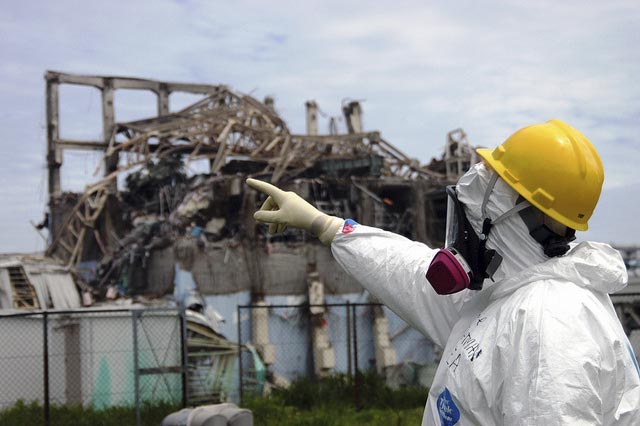
Only luck and real courage at 14 nuclear reactors on Japan’s Pacific coast overcame the technical failures of nuclear power and prevented the nation from being destroyed by radiation.
The untold story of March 11, 2011 is how close Japan came to three more spent fuel pool fires at Fukushima Daiichi and four meltdowns at Fukushima Daini.
When the magnitude 9.0 earthquake off the Pacific coast caused a seismic shock wave that reverberated throughout northern Japan, the country’s nuclear plants shut down automatically, as planned, preventing any further nuclear chain reactions.
Therein lies nuclear power’s fatal flaw, because an automatic shutdown does not stop the ongoing heat generated inside each nuclear reactor.
When uranium atoms split (a process called fission), they release tremendous energy, as well as rubble. Even when the chain reaction stops, the highly radioactive rubble emits decay heat that continues for years. Automatic shutdown simply means that no new nuclear fissions will occur.
A tsunami struck the west coast of Japan at Fukushima Daiichi just 45 minutes after the earthquake and plant shutdown, damaging all six nuclear reactors at the site and destroying shoreline emergency cooling water pumps.
The tsunami flooded Fukushima Daiichi’s emergency diesel generators. This is portrayed as the cause of the triple meltdown, because without diesel generators producing electricity, the plant could not be cooled.
Some have suggested that the diesel generators should be relocated so they are higher than a tsunami could reach, but this is the wrong solution to the wrong problem.
When the tsunami struck, the cooling equipment along the shoreline was turned into a scrap yard of twisted metal. Even if they had not been flooded, without operational shoreline pumps, the emergency diesel generators were doomed to fail, making it impossible to cool the nuclear core. In truth, the utter destruction of the shoreline pumps caused the triple meltdown at Fukushima Daiichi.
The tsunami also wrecked cooling pumps at eight other reactors located at Fukushima Daini, Onagawa, and Tokai.
Twenty-four of the 37 emergency diesel generators located at four separate nuclear power sites, which contained a total of 14 nuclear reactors, failed during the tsunami. Of the 24 diesel generators that failed, only nine failures were due to flooding (eight at Fukushima Daiichi and one at Fukushima Daini). The other 15 diesel generators were not flooded, but were disabled when the tsunami wrecked their shoreline cooling pumps.
The situation in Japan was dire when the sun set on March 11, 2011. At Fukushima Daiichi, three reactors were melting down and three spent fuel pools were at risk of catching fire because they could not be cooled. Conditions were also worsening at Fukushima Daini’s four reactors.
It was good fortune and extreme courage that saved Japan and its people from a more tragic catastrophe.
First, the wind blew out to sea rather than inland. Experts have acknowledged that only 20 percent of Fukushima’s airborne radiation releases blew inland, while 80 percent streamed out to sea. If the wind had blown in the opposite direction, exposure to radiation would have been five times worse, and Tokyo would have been evacuated.
Fortunately, the tsunami-generating earthquake struck during a normal workday, when almost 1,000 people were working at Fukushima Daiichi and thousands more were working at Fukushima Daini. The employees trapped on site fought courageously to mitigate the escalating catastrophe. Without their efforts, Japan could have had as many as 10 nuclear meltdowns and simultaneous spent fuel fires.
If the earthquake and tsunami had begun at night, only 200 employees would have been working at these plants. With roads and bridges destroyed, none of the necessary staff would have been able to return to work.
Now, more than three years after the Fukushima Daiichi disaster, shoreline cooling pumps throughout the world – including in Japan – remain unprotected from flooding or terrorist attacks.
Japan is prone to earthquakes and tsunamis. Is reopening its nuclear plants worth the risk to its people and their homeland?
The simultaneous technological failure at 14 nuclear reactors due to a single natural phenomenon clearly shows that the nuclear engineers who envisioned and designed nuclear power failed to expect the unexpected.
Unfortunately, the nuclear industry continues to push its message that nuclear power can be made safer. Fukushima, and before it Chernobyl, shows us that nuclear technology will always be able to destroy the fabric of a country in the blink of an eye.
Join us in defending the truth before it’s too late
The future of independent journalism is uncertain, and the consequences of losing it are too grave to ignore. We have hours left to raise the $12,0000 still needed to ensure Truthout remains safe, strong, and free. Every dollar raised goes directly toward the costs of producing news you can trust.
Please give what you can — because by supporting us with a tax-deductible donation, you’re not just preserving a source of news, you’re helping to safeguard what’s left of our democracy.